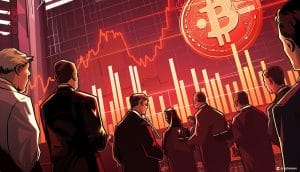Bitcoin Price to Face Another Test as Central Banks Eye Rate Hikes

The price of bitcoin (BTC) and other cryptoassets could be facing some headwinds in the coming months as central banks around the world one by one get ready to say goodbye to the ultra-loose monetary policies brought about by the COVID-19 pandemic.
As the first central bank in a Western developed nation to do so following the onset of the pandemic, Norway’s central bank, the Norges Bank, this week hiked its interest rate from 0% to 0.25%, citing a need to “begin a gradual normalization of the policy rate” as the economy is “normalizing.”
“The reopening of society has led to a marked upswing in the Norwegian economy, and activity is now higher than its pre-pandemic level,” Norges Bank further justified the rate hike. It added that the rate will “most likely be raised further in December.”
And although Norway’s rate hike may be insignificant in itself, central banks tend to follow each other when it comes to interest rate policies, as pointed out by Nik Bhatia, bitcoin advocate and author of the book Layered Money:
Tightening cycles usually spread from one central bank to the next. First rate hikes in the West have started in Norway. https://t.co/Q4ofwdnq28
— Nik Bhatia (@timevalueofbtc) September 23, 2021
Also setting the stage for tighter monetary policies ahead, the Bank of England (BoE) on Thursday, while keeping rates unchanged, warned that “global inflationary pressures have remained strong.” It also noted that “cost pressures may prove more persistent” than previously believed.
Similarly, the US Federal Reserve (the Fed) this week also decided to keep rates unchanged, although it noted in its statement that “inflation is elevated,” and that it is “on track to moderately exceed 2% for some time.”
2% is the Federal Reserve’s stated long-term inflation target.
In comments to reporters, the Fed chair Jerome Powell said that tapering – meaning a drawdown of the central bank’s USD 120bn in monthly bond purchases to support financial markets – could start as early as the next Fed meeting in early November, provided that the job market remains “reasonably strong.”
With a rising inflation rate and tighter job market, some analysts say the market now almost appears relieved that the Fed is moving towards tapering and raising rates.
“The US economy doesn’t need large amounts of liquidity anymore. There’s almost a sense of relief that the Fed is getting on with it and going back to normal,” Paul Donovan, global chief economist at UBS Group AG Wealth Management, told Bloomberg on Thursday.
And while it is often assumed that high inflation is good for bitcoin, rising interest rates is seen as a headwind for hard assets like bitcoin and gold, given that it makes bank deposits appear more attractive again.
It should be noted, however, that with the Fed’s inflation expectations ranging from 2.4% to 3.4%, and interest rates potentially moving up a quarter of a percent from zero, real rates – meaning the interest rate received after adjusting for inflation – still remain deep within the negative territory.
Still, looking back at bitcoin’s recent price history, even talks about potential rate hikes, especially in the US, have led to losses for the number one cryptocurrency, with central bank meetings in April and June leading to selloffs of between 2% and 5% over the next day.
Following this week’s decision in the US to keep rates unchanged, however, bitcoin reacted by trading higher over the next two days, until a China-triggered selloff occurred on Friday.
At 13:41 UTC, BTC was trading at USD 41,554 and was down 6% in a day and 13% in a week.
____
Learn more:
– Bitcoin & Inflation: Maturing Into A Real Asset
– Rising Inflation: Unless UK Acts Now, It Will Not Be Temporary
– Bitcoin Faces Hedge Test Amid Rising Inflation Concerns
– The Great Depression and Money Printers of Today
– Central Banks Will Need To Rethink Monetary Policies – PayPal CEO
– Bitcoin Is More ‘Public’ Money than Central Bank-Issued Fiat Currencies
– Prepare For ‘Uncertain Future of Money’ – US Intelligence Center
– Bitcoin vs. Modern Monetary Theory




